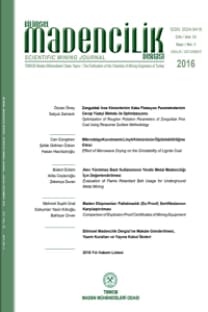Düşük tenörlü barit cevherinin (Kozan/Adana) zenginleştirilmesinin araştırılması
Bu çalışmada; Kozan-Adana bölgesinde bulunan düşük tenörlü/kalite barit cevherinin, jig ve sallantılı masa yöntemleri uygulanarak dolgu barit kalitesinde ve ayrıca jig ile zenginleştirme sonrası elde edilen konsantrelerin flotasyon ve kimyasal liç sonrası kimyasal kalite barit üretilmesinin hedeflendiği optimal zenginleştirilmesi araştırılmıştır. Deneysel çalışmalarda kullanılan cevher örnekleri SDS Madencilik Ltd. Şti. (Kozan/Adana) işletmesi maden stok sahasından temsili numune alma prensiplerine göre alınmıştır. Jig testleri için; -15+10 mm, -10+6 mm ve -6+3 mm tane boyut aralığı ve sarsıntılı masa testleri için ise -3+2 mm, -2+1 mm ve -1 mm tane boyut aralığı Besleme Malı kullanılmıştır. Jig konsantresi ise bilyeli değirmende yaş öğütme işlemi sonrası (d100 = 0,5 mm) flotasyon testleri ve kimyasal liç testleri için kullanılmıştır. Her bir deneysel çalışmada elde edilen konsantrelerin BaSO4 değerleri PAnaltyical marka X-ışını flüoresans (XRF) cihazı ve ayrıca yaş yöntem çözündürme ve ağırlık kaybı metotlarıyla belirlenmiştir. Beyazlık değerinin belirlenmesi için Kett Electric Laboratory (C-100-3) marka cihaz kullanılmıştır. Yoğunluk değerlerinin tespiti için ise piknometre yöntemi (TS EN 1097-7) kullanılmıştır. Ticari olarak üretilen dolgu barit kalitesinde barit ile kıyaslanabilecek özelliklere sahip en iyi konsantre (%96,12 BaSO4; %72,2 Beyazlık Değeri ve 4,2 g/cm3 yoğunluk) jig işlemini sonrası elde edilmiştir. Deneysel çalışmaların sonucunda bu tip barit cevherler için olası zenginleştirme proses akım şeması oluşturulmuştur.
Anahtar Kelimeler:
Barit, Zenginleştirme, Jig, Sarsıntılı masa, Gravite zenginleştirme
Investigation of processing of low-grade barite ores (Kozan/Adana)
In this study, beneficiation of barite ores from Kozan-Adana region was investigated using jig and shaking table to produce filler quality barite then the concentrate obtained by jigging also was used for flotation and chemical leaching experimental work producing chemical grade barite products. For experimental study, samples were taken from SDS Madencilik Ltd. mining stockpile using proper sampling methods. For jigging tests; -15+10 mm, -10+6 mm and –6+3 mm sized samples, for shaking table tests; -3+2 mm, -2+1 mm and -1 mm sized samples were used. Also the jigging concentrate after wet grinding with a ball mill (d100 = 0.5 mm) was used for flotation and chemical leaching tests. BaSO4 values of the concentrates obtained in each experiment were determined by PAnaltyical model X-ray fluorescence spectrometer (XRF), by wet method dissolution and also weight loss methods. Kett Electric Laboratory (C-100-3) model device was used to determine the whiteness value of the products. Pycnometer method (TS EN 1097-7) was used to determine the specific gravity of the products. A concentrate, having 96.12% BaSO4, 72.2% whiteness and density of 4.2 g/cm3, comparable properties to commercial filler quality barites, was obtained using jigging process. A potential flowsheet was proposed considering results obtained by the experimental study.
Keywords:
Barite, Processing, Jig, Shaking table, Gravity processing,
___
- American Petroleum Institute, 2010. Purchasing Guidelines Handbook: Specification for Drilling Fluids—Specifications and Testing. API Specification 13A, 18th edn, 1–22.
- Atak, S. 2017. Flotasyon Cevher Hazırlamada 100 Yıl. İTÜ Vakfı Yayınları.
- Batouche, T., Bouzenzena, A., Messai, A. 2018. Beneficiation methods of barite ore in Algeria. 9ème congrès national de la Société Algérienne de Chimie USTHB, Alger, 8-10 Mai 2018.
- Bhatti, M. A., Kazmi, K. R., Mehmood, R., Ahad, A., Tabbassum, A., Akram, A. 2017. Beneficiation study on barite ore of duddar area, District Las- bela, Balochistan Province, Pakistan. Pakistan Journal of Scientific & Industrial Research Series A: Physical Sciences, 60 (1), 9-22.
- Curreli, L., Ghiani, M., Zucca, A. 1994. Production of baryte concentrates for specials uses. 5. International Mineral Processing Symposium, Sep 6-8, Cappadocia (Turkey), 269-275.
- Deniz, V., Güler, T. 2018. Production of white barite from barite concentra- tes of shaking tables by bleaching process after magnetic methods. Inzynieria Mineralna, 19 (1), 77-82.
- Hodge, R. M., Augustine, B. G., Burton, R. C., Sanders, W. W. 1997. Evalua- tion and selection of drill-in-fluid candidates to minimize formation damage. SPE Drill & Compl., 12 (03), 174–179.
- Molaei, N., Razavi, H., Chelgani, S. C. 2018. Experimental modeling for upg- rading of brown barite ore by different processing methods. Mode- ling Earth Systems and Environment, 4 (1), 89-96.
- Otoijamun, I., Kigozi, M., Adetunji, A. R., Onwualu, P. A. 2021. Characteriza- tion and suitability of igerian barites for different industrial applica- tions. Minerals, 11 (4), 360, 1-11.
- Önal, G. 1980. Flotasyon Dışındaki Cevher Hazırlama Yöntemleri. İTÜ Mat- baası, İstanbul.
- Özbaş, K. E., Hiçyılmaz, C., Özbayoğlu, G. 1995. Beylikahir barit ve fluorit minerallerinin zenginleştirilmesi, 1. Endüstriyel Hammaddeler Sem- pozyumu, Nisan 21-22, İzmir (Türkiye), 7-14.
- Özer, H. 2007. Oksit flotasyonunda tane boyutu, hidrofobiklik, köpük yapısı ve mekanik taşıma arasındaki ilişki [master tezi]. [Isparta]: Süleyman Demirel Üniversitesi.
- Raju, G. B., Ratchambigai, S., Rao, M. A., Vasumathi, N., Kumar, T. V., Prab- hakar, S., Rao, S. S. 2016. Beneficiation of barite dumps by flotation column; lab-scale studies to commercial production. Transactions of the İndian İnstitute of Metals, 69 (1), 75-81.
- Sonmez, A., Versan, K. M., Ozel, R. 2013. Performance analysis of drilling fluid liquid lubricants. J Petrol Sci Eng., 108, 64–73.
- TS EN 1097-7, 2009. Agregaların mekanik ve fiziksel özellikleri için de- neyler-Bölüm 7: Dolgu malzemesi tane yoğunluğunun tayini - Pikno- metre yöntemi, Ankara.
- Ulusoy, U. 2019. Quantifying of particle shape differences of differently milled barite using a novel technique: Dynamic image analysis. Ma- terialia, 8, 100434.
- ISSN: 2564-7024
- Yayın Aralığı: Yılda 4 Sayı
- Yayıncı: TMMOB Maden Mühendisleri Odası
Sayıdaki Diğer Makaleler
Mete Tayhan SERDENGEÇTİ, Bekir BAŞKURT, Kaan ÖZÇELİK, Hüseyin BAŞTÜRKCÜ
Kaya kütle makaslama dayanımının geri analiz yöntemi ile belirlenmesi: Bir vaka analizi
Ogün Ozan VAROL, Mustafa AYHAN, Mutluhan AKIN
Yeni yaylı plaka kullanımı ile sürtünmeli kaya saplamaları performanslarının iyileştirilmesi
Düşük tenörlü barit cevherinin (Kozan/Adana) zenginleştirilmesinin araştırılması
